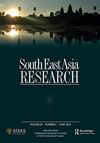Bangkok middle-class spectatorship and social realist media: contesting modernity through visualizing Muslim minorities
IF 0.9
3区 社会学
0 ASIAN STUDIES
引用次数: 0
Abstract
ABSTRACT Since the escalation of violence in the three southern border provinces of Thailand began in 2004, the body of literature on Thai Muslims has grown, with newer works offering fresh insights into the deep-rooted conflict. That said, scholarly works gauging the interplay between media portrayals of Muslim minorities and ideological works are surprisingly scarce. To fill the gap, this article examines social realist media, namely films and a music video, produced in the 1980s. Drawing on visual culture and Thai postcolonial studies as theoretical underpinnings, it seeks to illuminate the interplay between Bangkok middle-class spectatorship and Muslim minorities by framing them within Thailand’s postcolonial context. The findings show that visual references to Muslimness are made to connote inferiority vis-à-vis the supposedly modern Bangkok middle class. The article argues that, in the 1980s, the visuality of Muslimness enabled the newly formed Bangkok middle classes to forge a superior visual subjectivity while perpetuating ‘Muslim others’ as a group in need of development by the aforementioned middle class. Furthermore, emerging from the postcolonial world, visuality became a site of struggle in which the emerging classes contested the notion of modernity that had hitherto been exclusively intertwined with the elites.曼谷中产阶级观众和社会现实主义媒体:通过可视化穆斯林少数民族来对抗现代性
自2004年泰国南部边境三省的暴力冲突升级以来,有关泰国穆斯林的文学作品不断增多,新作品对根深蒂固的冲突提供了新的见解。也就是说,衡量媒体对穆斯林少数民族的描绘与意识形态作品之间相互作用的学术著作少得惊人。为了填补这一空白,本文考察了20世纪80年代制作的社会现实主义媒体,即电影和音乐视频。它以视觉文化和泰国后殖民研究为理论基础,试图通过将曼谷中产阶级观众和穆斯林少数民族置于泰国后殖民背景下来阐明他们之间的相互作用。调查结果显示,在视觉上提到穆斯林是为了暗示与-à-vis所谓的现代曼谷中产阶级相比,他们是低人一等的。文章认为,在20世纪80年代,穆斯林的视觉性使新形成的曼谷中产阶级形成了一种优越的视觉主体性,同时使“穆斯林他人”作为一个需要上述中产阶级发展的群体永存。此外,从后殖民世界出现,视觉成为一个斗争场所,新兴阶级在其中对迄今为止只与精英纠缠在一起的现代性概念提出质疑。
本文章由计算机程序翻译,如有差异,请以英文原文为准。
求助全文
约1分钟内获得全文
求助全文
来源期刊

South East Asia Research
ASIAN STUDIES-
CiteScore
1.90
自引率
0.00%
发文量
42
期刊介绍:
Published three times per year by IP Publishing on behalf of SOAS (increasing to quarterly in 2010), South East Asia Research includes papers on all aspects of South East Asia within the disciplines of archaeology, art history, economics, geography, history, language and literature, law, music, political science, social anthropology and religious studies. Papers are based on original research or field work.
 求助内容:
求助内容: 应助结果提醒方式:
应助结果提醒方式:


